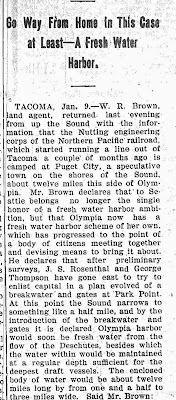Prenote: If you’re thinking about suicide, talk to someone right this minute. Call 1-800-273-8255 or visit the National Suicide Prevention Lifeline.
It had been six years since the Capitol building in Olympia, Washington had been completed. Walter Wilder was in his home in Suffern New York, less than a mile from the New Jersey border.
While much of his life’s work was within a day’s travel of where he was at that moment, his and his partner’s largest work was 3,000 miles away on the the other side of the country. Also there was Florence Tunnard.
Wilder would shoot himself two years after his partnership with Harry White dissolved, after his mental health had spiralled downward and after his wife refused to let him divorce her in favor of Ms. Tunnard.
I wonder how in the day Wilder took his life if his mind wandered back to Olympia. The day the architecture firm got world over 20 years earlier that they’d won a contest for a new state capitol campus that would become their largest project. To the years he spent seeing his drawings come to life on the hill above the town on the edge of Puget Sound. And to Florence, the stenographer working at the state Attorney General’s office that he had fallen for.
At least in my part of the world, Harry White and Walter Wilder are most well known for the capitol in Olympia. It is a set of sandstone structures that to the amateur seem to emulate the national capitol in the other Washington. To the only slightly more informed, they are representations of an architectural movement called “City Beautiful.”
The dozens of other projects Wilder and White completed in their lives — houses, office buildings and college buildings — dot the New York and New Jersey region. They were successful in their own small way as architects, working consistently until the depression took hold and Wilders’ sanity lost hold.
In the end, the capitol group envisioned by Wilder and White was never built. After the construction of the original three buildings — the Temple of Justice, the domed legislative building and the insurance building — the state capitol planners took a break. The legislative building stood in the center of the unfinished group until the the middle of the Great Depression.
The state capitol commission eventually turned its attention to the back of the campus. With ample public money coming from the federal government for public works projects, the commission hired Olympia architect Joseph Wohleb to finish off the Wilder and White campus.
Wohleb is surprisingly similar to Wilder and White. If not for ignoring any contests to design state capitol buildings in eastern cities, Wohleb had a shockingly parallel career to the New York pair. His work is spread almost exclusively throughout the Northwest and mainly in Olympia. But, when it came to competing the last buildings constructed in the 1911 proposal, the state went to their home grown architect.
Wohleb had moved to Olympia just as Wilder and White had finished their original plans. As he put his head down and went on designing over 150 buildings throughout the decades. Surely, he would also look over his shoulder to watch Wilder and White at work.
But, in 1935 with Wilder dead and White still working in the east, those last two buildings were his to design. While it was outside his normal style, the stayed true to the partner’s original, classical style.
After that, the campus would turn west. forgetting the final pieces Wilder and White drew. One last office buliding (a matching pair to the insurance building, which flanks the legislative building on the east) was never built. Also, the once temporary governor’s mansion, (a permanent mansion envisioned by Wilder and White was to overlook Puget Sound on a bluff), is still hidden too far south.
In the 1950s and 1960s, the campus would creep east across Capital Way, further changing the original Wilder and White orientation from a northern facing to east. An entire neighborhood would be lost underneath new campus buildings.
One house that was eventually removed from Capitol Way — mercifully moved in one piece a mile to the south — was the Egbert-Ingham house. This house was where Walter Wilder lived when he met Florence Tunnard, the love for whom he would eventually kill himself.
Eventually, his campus would expand beyond his vision to uproot the house to the south. The owner of the house in the 1970s put it up on wheels and put it down where it still is today.




